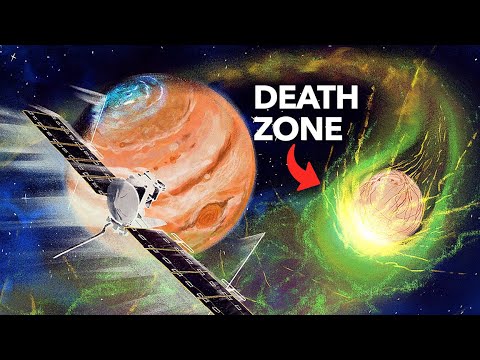The video outlines NASA’s Europa Clipper mission, launching in October 2024, which will explore Jupiter’s moon Europa for signs of extraterrestrial life while navigating the challenges posed by the moon’s intense radiation environment. The mission aims to gather data on Europa’s subsurface ocean and potential hydrothermal vents, with initial observations expected by 2030, marking a significant step in the search for life beyond Earth.
The video discusses NASA’s upcoming Europa Clipper mission, set to launch in October 2024, which aims to explore Jupiter’s moon Europa as a potential site for extraterrestrial life. The narrative begins with a reference to Arthur C. Clarke’s novel “2010: Odyssey Two,” which suggested that Europa might be off-limits due to its potential for harboring life. The video highlights the challenges posed by Jupiter’s intense radiation, which creates a hostile environment for life and complicates the design of a spacecraft capable of surviving in such conditions.
Jupiter’s powerful magnetic field, generated by metallic liquid hydrogen deep within the planet, creates radiation belts that can damage electronic instruments. Previous missions, like Pioneer 10 and Voyager, experienced data corruption due to this radiation. To mitigate these risks, the Europa Clipper will not orbit Europa directly but will instead conduct 49 flybys over four years, allowing it to gather data while avoiding prolonged exposure to harmful radiation.
The video explains why Europa is a prime candidate for the search for life. Unlike other moons, Europa’s surface shows few craters, suggesting geological activity that could indicate a subsurface ocean. Data from the Galileo mission revealed a conductive layer beneath the icy crust, likely a salty ocean that could be 100 kilometers deep. This ocean, kept warm by tidal flexing caused by gravitational interactions with Jupiter and other moons, could provide the necessary conditions for life to thrive.
The potential for life on Europa is further supported by the presence of hydrothermal vents, similar to those found on Earth, which could provide energy and nutrients for microbial life. The video emphasizes that while Europa has been bombarded by radiation, this could actually create new compounds that might serve as food for life forms beneath the surface. The Europa Clipper will utilize various instruments to analyze the moon’s surface and search for signs of life, including infrared and ultraviolet spectrometers.
Finally, the video touches on the collaboration between NASA and the European Space Agency’s JUICE mission, which will also study Jupiter’s moons. The Europa Clipper is expected to provide initial observations by 2030, with high-resolution data following in 2031. The excitement surrounding the mission reflects decades of planning and research, culminating in a significant step toward understanding the potential for life beyond Earth. The video concludes with a call to action, encouraging viewers to consider their own impact on the world, supported by a sponsorship from the nonprofit organization 80,000 Hours.
